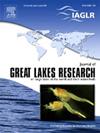冷水中的蓝藻:苏必利尔湖近岸蓝藻群研究
IF 2.5
3区 环境科学与生态学
Q3 ENVIRONMENTAL SCIENCES
引用次数: 0
摘要
蓝藻藻华通常与温暖、富营养化的湖泊有关,由于其对生态和公共健康的潜在破坏而受到广泛关注。最近,在寡营养湖泊(包括大型冷水湖泊苏必利尔湖)中也观察到了蓝藻藻华。尽管最近取得了一些进展,但针对苏必利尔湖北部近岸浮游植物群的研究还很有限,自 2019 年以来,该地区出现了孤立的蓝藻水华。2019 年,我们对 10 个近岸监测站的蓝藻群进行了研究,以了解潜在的藻华形成类群及其与水质的关系。我们观察到蓝藻的多样性,其中春季密度最高,秋季生物量最大。在不同地点和不同季节,藻类中最常见的物种是藻蓝蛋白和藻蓝蛋白。变异分区分析表明,与气象因素相比,水质条件对蓝藻密度和生物量的影响更大,尤其是在营养盐输入增加和暴风雨过后的地区。然而,目前蓝藻在研究区域浮游植物总生物量中所占比例还不到 15%。我们的监测数据和最近关于北岸蓝藻藻华的报告表明,目前的藻华并不普遍。尽管如此,我们还是发现了多种蓝藻类群,其中大多数都能产生蓝藻毒素。考虑到导致蓝藻藻华的各种因素在全球范围内的不确定性,以及影响苏必利尔湖的大规模气候变化,建议采取积极主动的方法来评估藻华风险。这应包括数据生成工作(如频繁的浮游植物监测和已报告的藻华调查),以支持未来以管理蓝藻藻华为重点的合作计划。本文章由计算机程序翻译,如有差异,请以英文原文为准。
Cyanobacteria in cold waters: A study of nearshore cyanobacteria assemblages in Lake Superior
Cyanobacterial blooms, often associated with warm, eutrophic lakes, are of widespread concern owing to their potential disruption of ecological and public health. Recently, cyanobacterial blooms have been observed in oligotrophic lakes, including Lake Superior, a large cold-water system. Despite recent developments, limited research has targeted phytoplankton assemblages in the northern Lake Superior nearshore, where isolated cyanobacteria blooms have emerged since 2019. In 2019, the cyanobacteria assemblage at 10 nearshore monitoring stations was examined to understand potential bloom-forming taxa and their association with water quality. We observed a diverse cyanobacteria assemblage, with highest densities in spring and biomass in fall. Pseudanabaena limnetica, Dolichospermum flos-aquae and Limnothrix sp. were the most prevalent species across sites and seasons. Variation partitioning analysis revealed that water quality conditions were more influential drivers of cyanobacteria density and biomass than meteorological factors, particularly in regions with elevated nutrient inputs and following stormy conditions. However, at present, cyanobacteria compose <15 % of the total phytoplankton biomass in the study areas. Our monitoring data and recent reports of cyanobacteria blooms on the north shore, suggests that current blooms are not widespread. Nonetheless, we found a diverse array of cyanobacteria taxa, with most capable of producing cyanotoxins. Considering the global uncertainty in the factors contributing to cyanobacteria blooms, in association with the large-scale climatic changes affecting Lake Superior, a proactive approach to assessing risks of blooms is suggested. This should include data-generating efforts (e.g., frequent phytoplankton monitoring and reported blooms investigations) to support future collaborative initiatives focused on managing cyanobacterial blooms.
求助全文
通过发布文献求助,成功后即可免费获取论文全文。
去求助
来源期刊

Journal of Great Lakes Research
生物-海洋与淡水生物学
CiteScore
5.10
自引率
13.60%
发文量
178
审稿时长
6 months
期刊介绍:
Published six times per year, the Journal of Great Lakes Research is multidisciplinary in its coverage, publishing manuscripts on a wide range of theoretical and applied topics in the natural science fields of biology, chemistry, physics, geology, as well as social sciences of the large lakes of the world and their watersheds. Large lakes generally are considered as those lakes which have a mean surface area of >500 km2 (see Herdendorf, C.E. 1982. Large lakes of the world. J. Great Lakes Res. 8:379-412, for examples), although smaller lakes may be considered, especially if they are very deep. We also welcome contributions on saline lakes and research on estuarine waters where the results have application to large lakes.
 求助内容:
求助内容: 应助结果提醒方式:
应助结果提醒方式:


